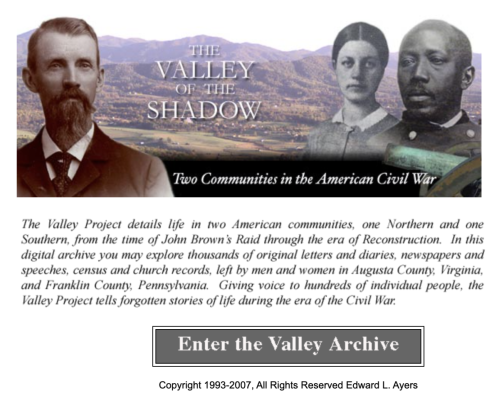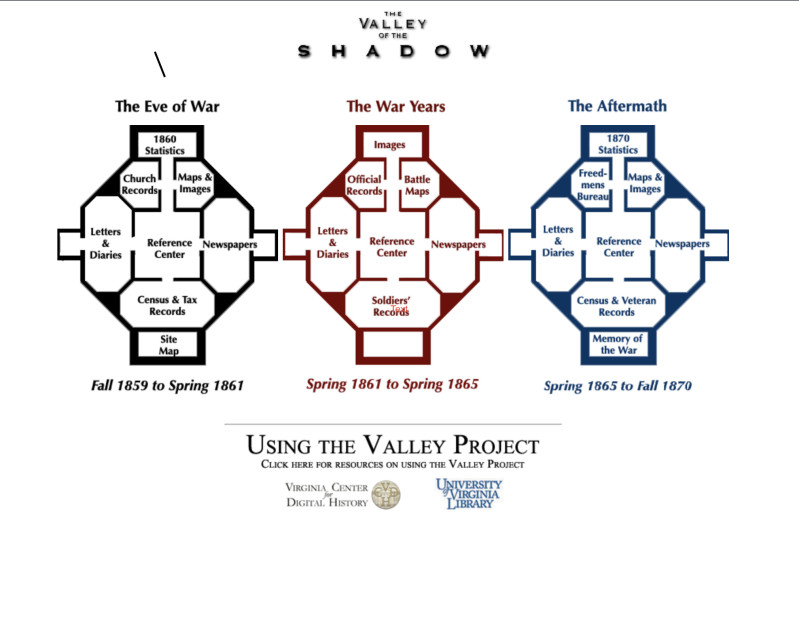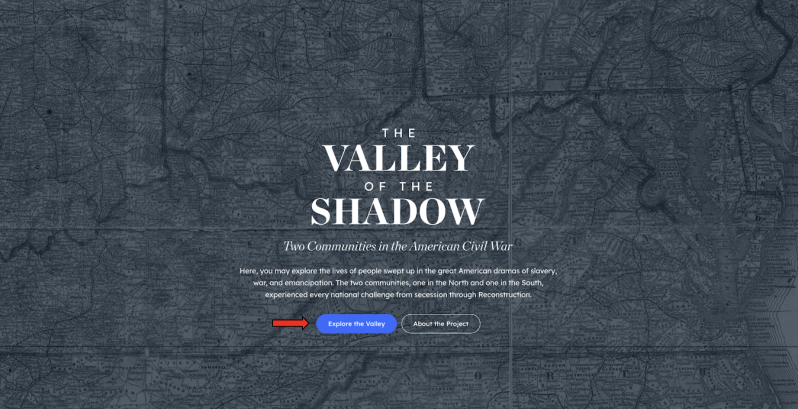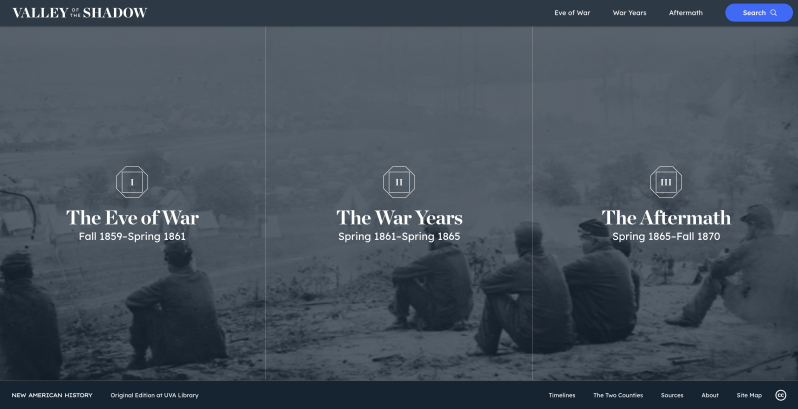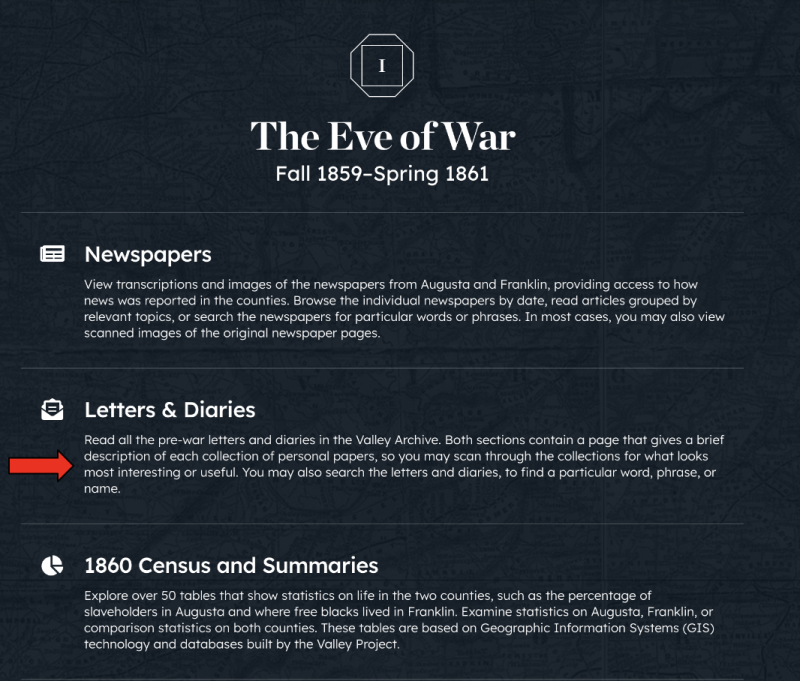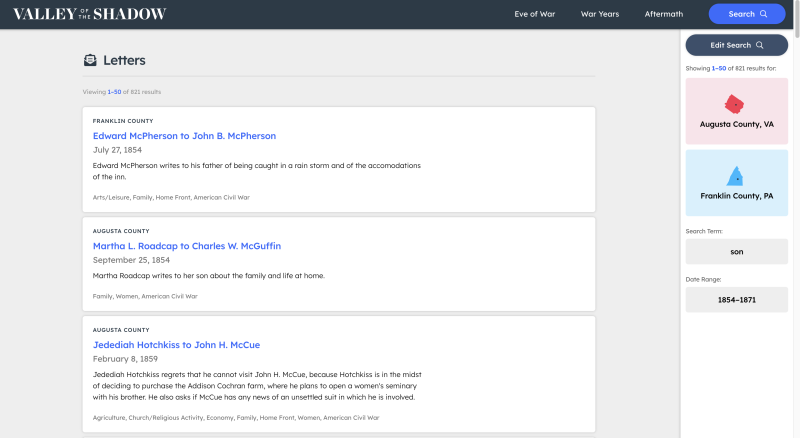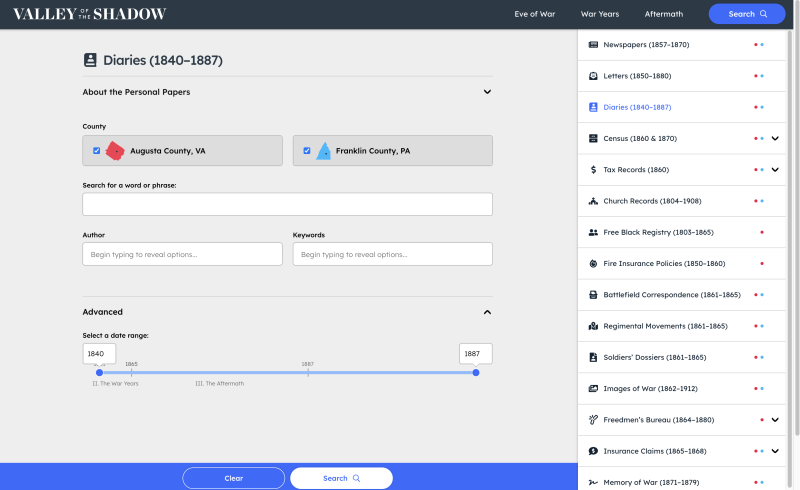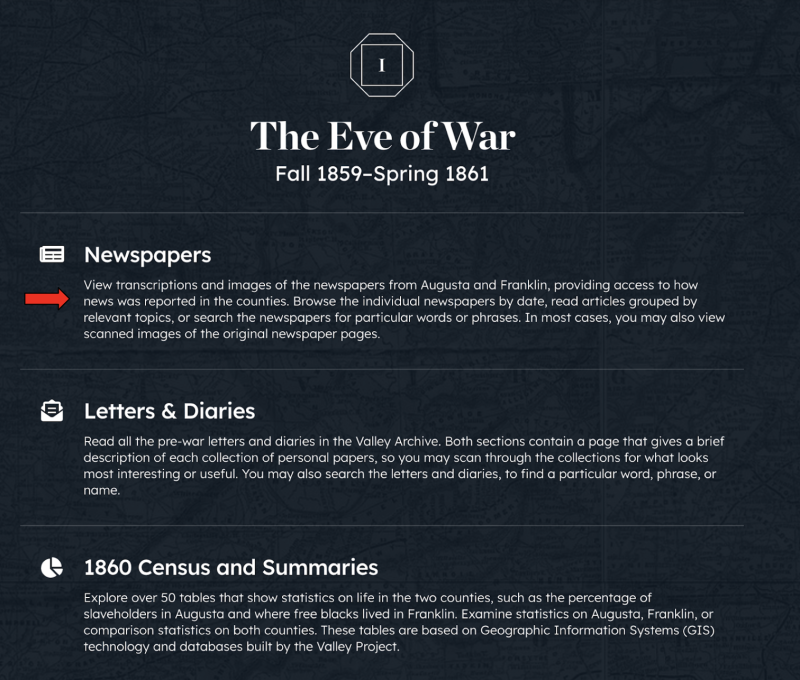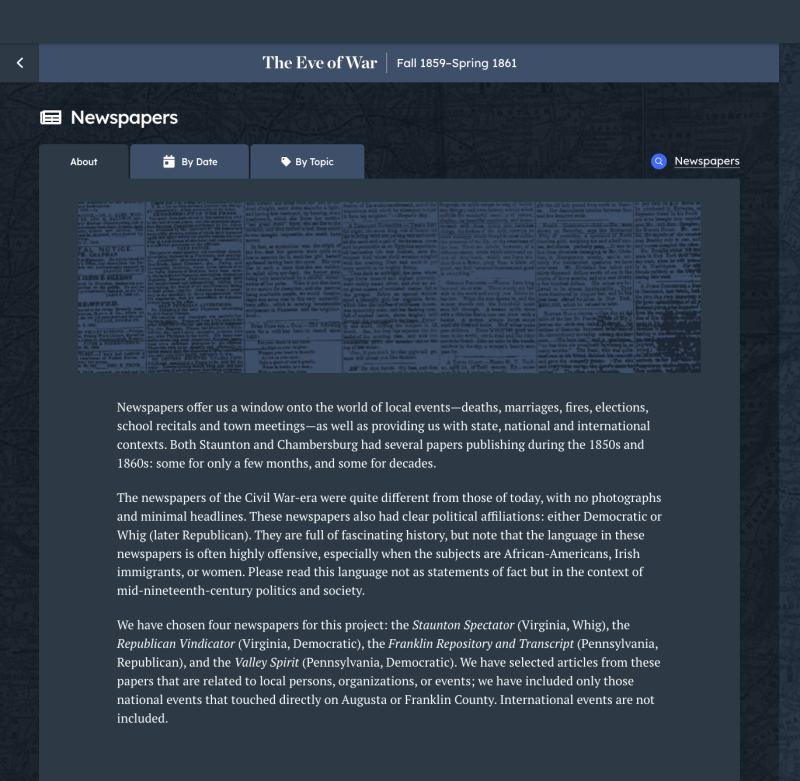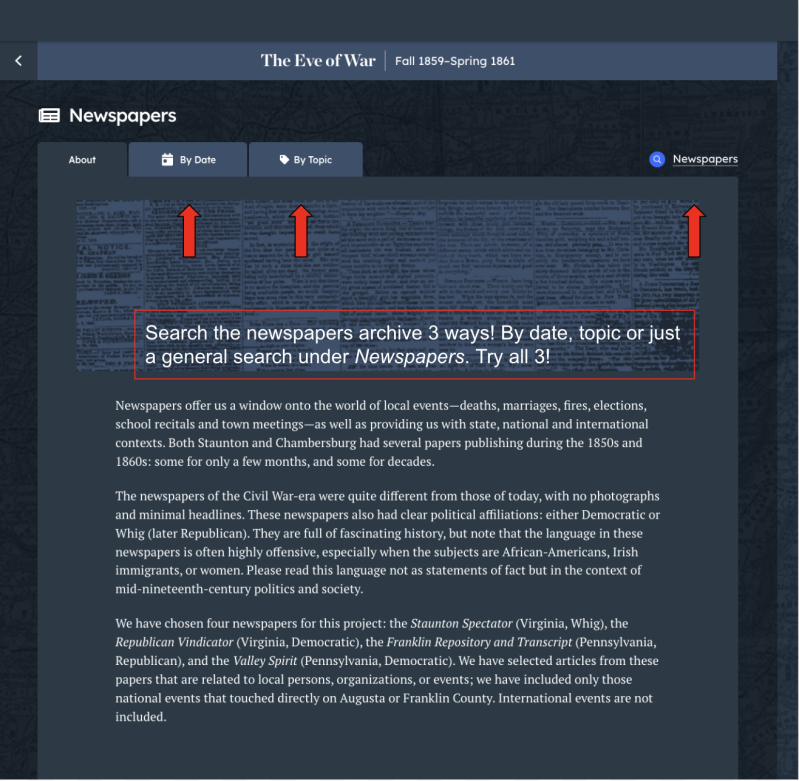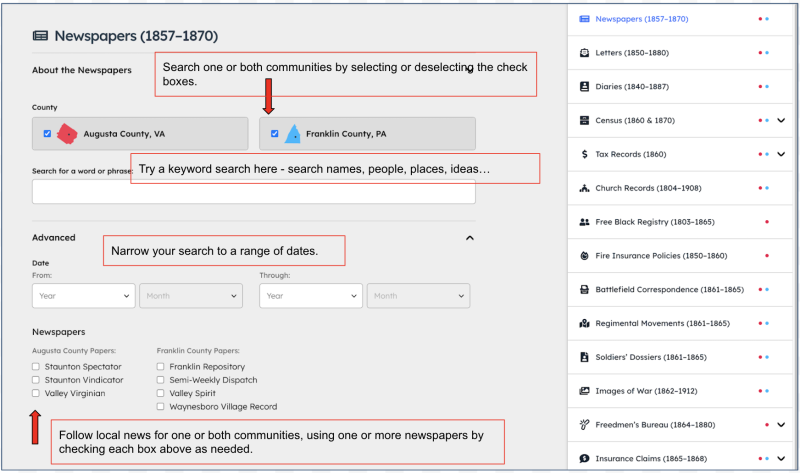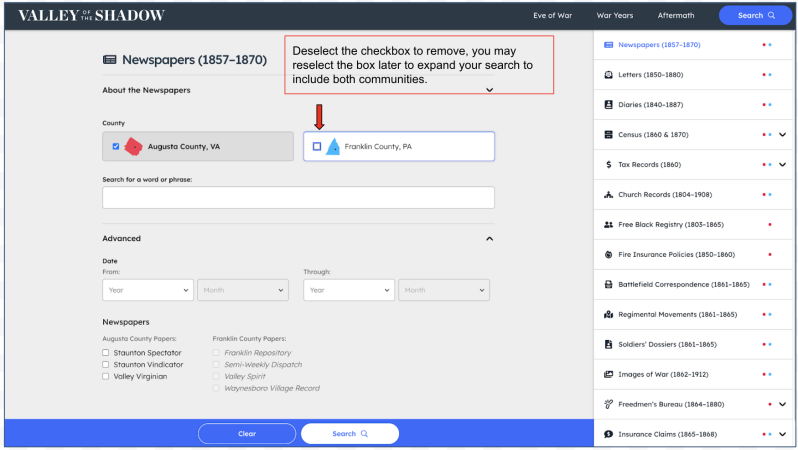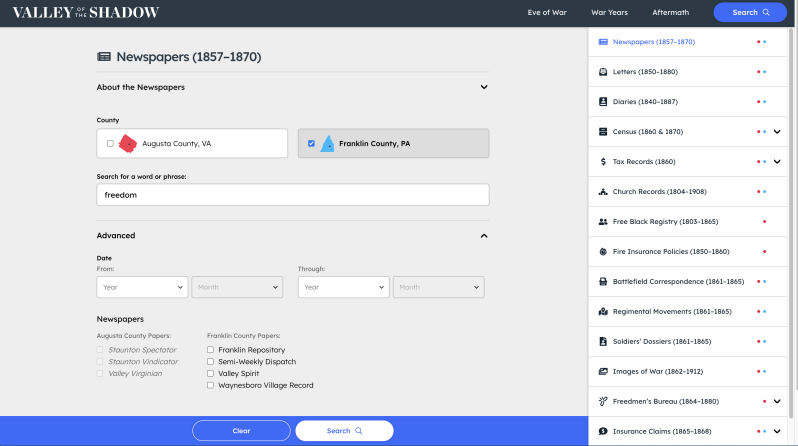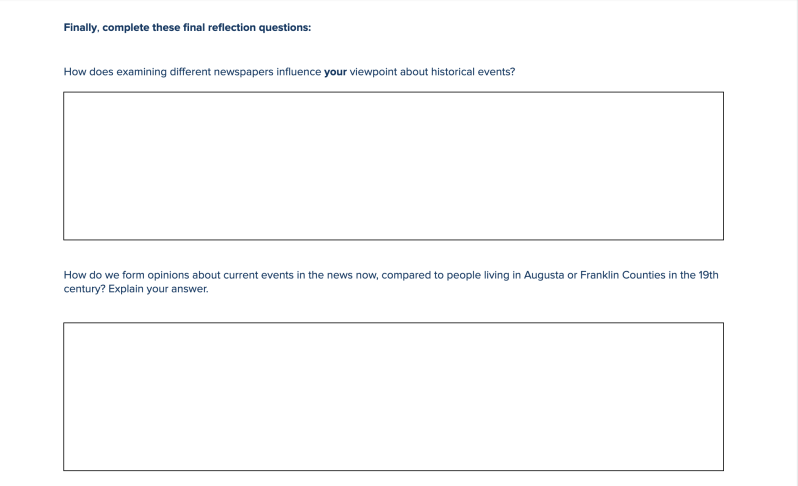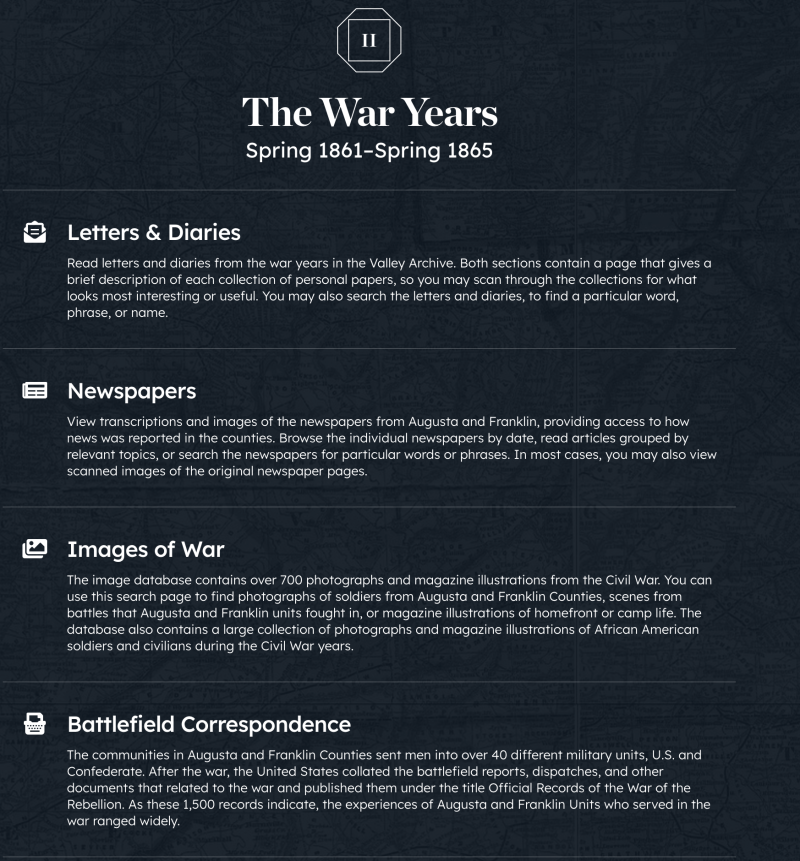This work by New American History is licensed under a Attribution-NonCommercial-ShareAlike 4.0 (CC BY-NC-SA 4.0) International License. Permissions beyond the scope of this license may be available at newamericanhistory.org.
The Valley of the Shadow
View Student Version
Standards
C3 Framework:D2.His.5.9-12. Analyze how historical contexts shaped and continue to shape people’s perspectivesD2.His.6.9-12. Analyze the ways in which the perspectives of those writing history shaped the history that they produced.D2.His.7.9-12. Explain how the perspectives of people in the present shape interpretations of the past.D2.His.8.9-12. Analyze how current interpretations of the past are limited by the extent to which available historical sources represent perspectives of people at the time.D2.His.16.9-12. Integrate evidence from multiple relevant historical sources and interpretations into a reasoned argument about the past.
National Council for Social Studies:Theme 3 - PEOPLE, PLACES, AND ENVIRONMENTSTheme 6 - POWER, AUTHORITY, AND GOVERNANCE
National Geography StandardsStandard 4. The physical and human characteristics of places.Standard 6. How culture and experience influence people’s perceptions of places and regions.
EAD Roadmap Connections: Design challenges: America’s Plural Yet Shared StoryCivic Honesty, Reflective Patriotism
Primary theme: Contemporary Debate and PossibilitiesHDQ7.4A How can your learning from U.S. history suggest strategies for how to address our shared contemporary problems?CDQ7.4B What specific methods have Americans developed for adapting or preserving their society, and what are the strengths and limitations of each as we look toward challenges in the future?
Teacher Tip: Think about what students should be able to KNOW, UNDERSTAND and DO at the conclusion of this learning experience. A brief exit pass or other formative assessment may be used to assess student understandings. Setting specific learning targets for the appropriate grade level and content area will increase student success.
Suggested Grade Levels: 6-8, 9-12Suggested Timeframe: 2 sessions, 45-90 minutes Suggested Materials: Internet access via laptop, tablet, or mobile device
Key Vocabulary
Archives - A storage system for letters, diaries, documents, reports, notes, memos, photographs, material culture, audio, and video recordings from the past.
Digital Archives - web-based sites that contain digital versions of resources found in a traditional archive.
Digital Humanities - a branch of digital scholarship focused on the humanities, including history, geography, literature, and the arts
Digital Scholarship - a modern approach to research that uses new technologies and digital data to advance teaching and learning
Primary Source - first-hand account, artifact, or material culture, (e.g. diaries, newspaper articles, pictures, public documents, clothing, recordings, and maps) from a specific time period or a historical event.
Toggle - to switch between one option and another.
Read for Understanding
Teacher Tips:
New American History learning resources include language to help adapt to a variety of educational settings, including remote learning environments, face-to-face instruction, and blended learning.
If you are teaching remotely, consider using videoconferencing to provide opportunities for students to work in partners or small groups. Digital tools such as Google Docs or Google Slides may also be used for collaboration. Rewordify and WordtuneRead help make a complex text more accessible for those reading at a lower Lexile level while still providing a greater depth of knowledge.
These Learning Resources use a Turn and Talk strategy to allow students to work with an “elbow partner” for brief collaborations. We excerpted a small clip from our collaborators at the American Civil War Museum in Richmond, Virginia, to introduce the Valley of the Shadow to a new generation. We hope you will view the full video here, and visit their site for additional information.
This Learning Resource follows a variation of the 5Es instructional model, and each section may be taught as a separate learning experience, or as part of a sequence of learning experiences. We provide each of our Learning Resources in multiple formats, including web-based and as an editable Google Doc for educators to teach and adapt selected learning experiences as they best suit the needs of your students and local curriculum. You may also wish to embed or remix them into a playlist for students working remotely or independently.
When engaging students with historical documents, it is important to prepare them for any unacceptable or offensive language used during specific historical eras. The National Archives policy may be a good place to start in this discussion prior to using the Valley of the Shadow or other historical archives. For the student version of these learning resources, we include the below adaptation of this statement as a note.
For Students:
Today you will begin exploring the Civil War Era by examining letters, diaries, and newspapers from two communities, one in the north and one in the south, as part of the Valley of the Shadow digital archives.
Note: Historical archives may contain some content that may be harmful or difficult to view. These archives span the history of the United States, from 1859-1870. The sources used to preserve and make available these historical records contain materials presented here that may reflect outdated, biased, offensive, and possibly violent views and opinions. In addition, some of the materials may relate to violent or graphic events and are preserved for their historical significance. It is important that you, as a learner, communicate with your teacher if you feel uncomfortable using a particular portion of these materials, as they may guide you to more age-appropriate sources or ones with less sensitive content within the archives.
Engage:
What is digital scholarship, and how does it help us learn about the past?
Digital Scholarship is a modern approach to research that uses new technologies and digital data to advance teaching and learning. A digital historian uses a variety of electronic media including primary source texts, images, and artifacts to study the past.
One of the earliest efforts to create and preserve digital historical resources was the Valley of the Shadow project. The Valley of the Shadow is a digital archive of primary sources that document the lives of people in two communities, one Northern and one Southern, through the experience of the American Civil War.
The digital humanities project was conceived by historian Ed Ayers and developed by students, digital archivists, and scholars at the University of Virginia. Watch Ayers describe his motivations for the original project here.
Take a few minutes to explore the original website, still hosted by the University of Virginia Library.
Select Enter the Valley. Explore the site independently. Spend some time in each section as seen in the site map below.
Turn and talk to a partner as directed by your teacher. If working remotely, your teacher may allow you to use breakout rooms through videoconferencing or share via a collaborative document such as Google Docs or Google Slides.
- What do you notice about the way the website is organized?
- What did you find surprising about the project?
- What did you find most interesting in the archives?
- What questions do you have about the Valley of the Shadow?
Now spend a few minutes exploring the Valley of the Shadow v2.0, hosted at New American History.
Select the About the Project button to read more about the history of the project.
- How does the author of this section of the website explain the reason a new version of the project was created?
- What similarities and differences are noted between the original site and this newer version?
- What goals do the project leaders hope to achieve?
Your teacher may ask you to record your answers on an exit ticket.
Explore:
What might we learn from reading people's diaries and letters?
Return to the Valley homepage and select Explore the Valley.
Take a few minutes to explore the updated Valley of the Shadow site.
Think about the original site you explored earlier and compare/contrast the original version to the new archives.
- What do you notice about the way the new website is organized?
- What did you find surprising about this version of the project compared to the original site?
- What did you find most interesting in the new archives?
- What questions do you have about the Valley of the Shadow v2.0?
People write diaries and letters for many reasons: to vent, to form and strengthen relationships, to improve their writing, to record happenings of historical and personal significance, to explore who they are and who they wish to be and to draft autobiographies and memoirs.
- Do you or anyone you know keep a journal or diary?
- In what format do people today typically document their daily thoughts, ideas, or memories?
- Have you written or received a handwritten letter?
- How do handwritten letters and diaries compare to digital messaging tools today?
Using the Valley project’s digital archives, you will examine a selection of historical diaries and letters. The digitized primary sources document people’s thoughts on slavery, war, civil rights, religion, and gender. They include the perspectives of both communities, one in the north and one in the south.
Select the Eve of War section first by clicking on the left-hand column. You should now be in the archives for Fall 1859–Spring 1861.
Select Letters & Diaries. Take a few minutes to read through the About section.
- How are the letters and diaries organized in the archives?
- What enhanced search features have been added to assist the reader in exploring the archives?
- What questions do you have about digital archives in general?
You may start your search either by selecting Letters or Diaries.
If you select Letters, read the” About the Personal Papers” section first to learn a bit more about how the letters are organized in the archive. You will use the toggle switch to open and read, then use it again to close the window.
Next, decide how you would like to begin searching the archives—you may search by a range of years, a keyword search, or by the community (Augusta County, Franklin County, or both).
Spend a few minutes exploring the Valley by searching for different keywords and date ranges. You’ll find a few suggestions below. Click Search to display your results.
When you select Search, it will share your results and you will be able to select a letter from the archives and begin reading!
Here is a letter we found from a mother to her son. Notice that you can select and read the “Original” letter as it was written in the mid-19th century, or the version labeled “Modern Spelling.” Take a moment to compare both versions.
- What do you notice?
- What does the letter make you think about or wonder?
- Can you find any more letters between Martha and her son, Charles? Where else might you find them or their family in the archives?
If you select Diaries, the process is very similar. Experiment using the search tools and explore some of the diary entries. Cross-reference the people you read about to see if there are letters or other mentions of them in other archives within the Valley project.
Try searching for some of the names in Mrs. Roadcap’s letter (above) to see if any of their family or friends in Augusta County kept a diary. Spend some time following one or two of these other folks as you continue to search the archives. Select a letter or diary entry you find most interesting to share with a classmate. You may repeat this same search in different eras using the menu bar in the top right corner.
We would love to hear about a letter or diary entry you find especially interesting. Check with your teacher or a trusted adult first, then email us at editor@newamericanhistory.org. You can also share a screenshot and your thoughts about the Valley of the Shadow using social media (links on our pages). Be sure to tag us as you share!
Your teacher may ask you to record your answers on an exit ticket.
Explain:
How do digital newspaper archives give new insights into the ways that the Civil War was interpreted by communities in the North and South?
People living in Augusta County, Virginia, and Franklin County, Pennsylvania did not have access to news in real time as we do in the modern era. They depended on letters and newspapers for information from outside their community. Local newspapers covered the daily happenings of each community, and also printed dispatches from places far from home, where relatives might live, or soldiers might be serving. Exploring newspaper archives is a way for us to explore the mindset, attitudes, and influences of those who published the local newspapers, and those who read them.
Return to the Valley of the Shadow and the Explore page. Select the Eve of War section.
Next, select Newspapers from the menu and take a few minutes to read the About section.
- The About section begins with “Newspapers offer us a window onto the world of local events…” What do you think is meant by this statement?
- How does the archive describe the similarities and differences between newspapers now and then?
- What is and is not included in the newspaper archives within the Valley of the Shadow project?
- Why do you think the creators of the archives chose to include these newspapers and events, but not others?
There are multiple ways to explore the newspapers included in the Valley archives. You may choose to explore by Date, Topic, or by a specific newspaper.
When you search by date, you will see a calendar-like menu with articles from a variety of newspaper sources. Take a few minutes to explore one or more articles, and practice using the tools below to narrow your search by date, publication, or even era. Now try exploring each way with at least one article from each community.
Turn and talk to a partner to share one or more articles you found interesting. If working remotely, your teacher may let you work using a collaborative document such as Google Docs or Google Slides, or meet virtually via videoconferencing.
- How are the newspaper archives organized?
- What similarities and differences do you notice between the way newspapers in each community report on a single topic?
- Whose perspectives are included or excluded in the article(s) you explored?
- Do you see any changes in the ways a topic or event is reported as time goes by?
- How might you search the archives differently to find out more about these changes?
- Where might you search to find more information about a topic you read about?
Take a few minutes to try a different pathway into the newspaper archives. This time, try Search by Topic. You may select a topic, then narrow your search to a subtopic, or across multiple eras. Spend a few minutes exploring a few topics of your choice. See if that topic continues to be represented in the archives across other eras, both during and after the war.
A search for “Parades and Holidays” led us to articles on France’s Napoleon Bonaparte, a political convention in Charleston, and one newspaper challenging the views of another. Each of these may be explored in more detail, including a link out to images of the original newspaper where you may explore firsthand what someone living in Augusta or Franklin counties would have seen as they followed the news.
A general search of the archives of the newspaper: You may select to search by one or both communities, a keyword or phrase, or a range of dates. You may narrow down your search to one or more specific newspapers. Try searching for a topic you expired earlier using this method for comparison.
Turn and talk again, following your teacher’s directions for collaborating with your classmates.
- Which methods seem best for beginning to research a new topic of interest?
- Which search methods seem best for locating specific content?
- What was the most interesting article you found?
- What was the most surprising article you found?
- How did the topic you explore change over time as you followed it across eras?
Your teacher may ask you to record your answers on an exit ticket.
Elaborate:
In what ways do newspapers reflect the varying interests, needs, opinions, or values of a community?
Exploring historical documents can help us better understand the people, places, and events we read about in history books or discover through movies, television, and video games. Historians rely on primary sources, including newspaper archives such as the Valley of the Shadow, to understand how ideas and values change over time. Read this brief description from Penn State University of how the growth of newspapers shaped the way people collected, reported, and consumed information.
Return now to the Valley of the Shadow archives and take a deeper look at how newspapers from Augusta County, Virginia, and Franklin County, Pennsylvania reported on similar topics or events.
Start with newspapers in the Eve of War portion of the archives. Select a topic or keyword (e.g. “freedom”) you might explore across all three eras. We started with Freedom. This graphic organizer may help you organize your thoughts. Make a digital copy or use the one provided by your teacher.
Try searching first with only newspapers from one of the two communities: Augusta County, Virginia. You will need to deselect the checkbox next to the map button of Franklin County, Pennsylvania. Scroll down to view the titles of articles related to or containing the keyword you selected.
Select an article of interest and read about how your keyword is included in the text of the article. Record your thoughts in one of the text boxes on the left side of your graphic organizer. Then select a second article using the same keyword from the Valley archives and complete the 2nd textbox for Augusta County. You may choose to search in a different era by changing the date using the advanced search features.
Remember, some newspapers were only published for a limited period of time, so may not be available in all eras.
Return to your search, deselect Augusta County, select Franklin County, then select Search, using the same keyword you used for your earlier search in Augusta County.
Select two different articles from Franklin County, Pennsylvania using that same keyword. Read and record your thoughts using the text boxes on the right side of your graphic organizer. Again, you may choose to search in a different era or narrow your search to 1-2 newspapers using the Advanced Search features.
When you are finished, complete these reflection questions in the space provided below the graphic organizer.
- How does examining different newspapers influence your viewpoint about historical events?
- How do we form opinions about current events now? How does that compare to the way people formed opinions about news in the 19th century? Explain your answer.
You may also try adding Sketchnotes/Sketchquotes to your responses.
Your teacher may ask you to record your answers on an exit ticket.
Extend:
Which public records would you use to find more specific information about the past?
The Valley of the Shadow archives contains thousands of documents including personal papers, newspapers, and public records. It took over four years for historian Ed Ayers, his students, and colleagues to find, organize, digitize and upload all these documents. You’ve now had an opportunity to explore some of the letters, diaries, and newspapers.
Working in pairs, as directed by your teacher, take a few minutes to explore one or more other categories included in the Valley of the Shadow archives. Be sure to explore all three eras, as the types of records available may change.
Look for documents that might help you answer these questions:
- Where did free Black people live in Augusta County, Virginia, or Franklin County, Pennsylvania?
- What do census data, church records, tax records, or military records tell us about family life in both communities?
- What visual records did you discover, and what stories might they tell?
- Whose stories are still hidden or untold by these records, and where might they be available now?
Your teacher may ask you to record your answers on an exit ticket.
Citations:
“What Is the Valley of the Shadow? Ed Ayers.” YouTube. New American History, excerpted from a video from the American Civil War Museum, May 1, 2015., October 9, 2022. https://www.youtube.com/watch?v=Uw693l4_dqI.
“Nara's Statement on Potentially Harmful Content.” National Archives and Records Administration. National Archives and Records Administration, June 17, 2022. https://www.archives.gov/research/reparative-description/harmful-content.
Valley of the Shadow: Two Communities in the American Civil War, New American History. http://valley.newamericanhistory.org.
Valley of the Shadow: Two Communities in the American Civil War, University of Virginia Library. http://valley.vcdh.virginia.edu/govdoc/popcensus.html.
View this Learning Resource as a Google Doc


